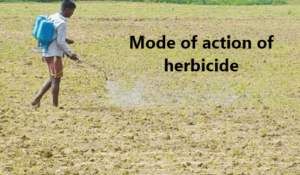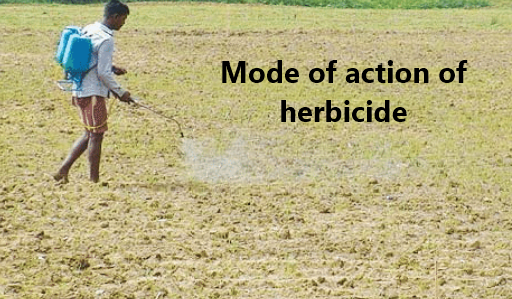 |
| Mode of action of herbicide. |
Mode of action of herbicides
The terms of mode of action of herbicide refer to the inter-sequence of event from the introduction of a herbicide into environment to the death of the plant. Thus it comprises some total morphological, anatomical, physiological, and biological responses of the plant that make up the total phytotoxic action of a herbicide.
The process associated with the mode of action of herbicide is –
Mode of action of contact herbicide:
Contact herbicide don’t move in the plant very far beyond the point of contact. Only plant tissues touched by the spray are killed. After spraying the herbicide, it reaches to cuticle, outer layer of epidermal cell and plasmalema from the surface of the plant. Finally increase at the protoplasm. When herbicide come in contact with living cell acute toxicity occur. Then the cell is death very fast all with in some minutes or several hours by severe toxic effect of herbicide. It is noted that, contact herbicide kill only that part of plant to which they come in contact. If stem is killed the leaves above will die. Thus the whole plant dies due to loss of functional integrity of the plant.
Eg. PCP, Paraquat.
Mode of action of translocate herbicide:
The part of translocated herbicide which enters a plant, moves in the plant and affect tissues and organs at a distance from the point of entry. Entry is generally through stem and leaves but may be through roots. Translocated herbicide may move in xylem or phloem or both. Both system are occur through diffusion. The translocated herbicide interfere with one or more of the physiological and metabolic process of the plant. Many of this process have been identify. Some of the identifying mechanism or mode of action which are stated below.
A. Physiological process:
a. Acting as mitotic poison. Eg. EPTC, Trifluralin
b. Regulating the growth. Eg. 2, 4 – D
c. Inhibiting shoot or germinating seedling. Eg. 2, 4 – D
d. Inhibiting root of germinating seedling
e. Causing cell enlargement.
f. Causing cell elongation.
g. Effecting tissue differentiation.
- B. Metabolic process:
a. Inhibiting photosynthesis.
b. Inhibiting phosphorylation.
c. Inhibiting biosynthesis.
d. Inhibiting respiration.
e. Inhibiting enzyme activity
f. Protein denaturation.
Useful Agricultural Websites
